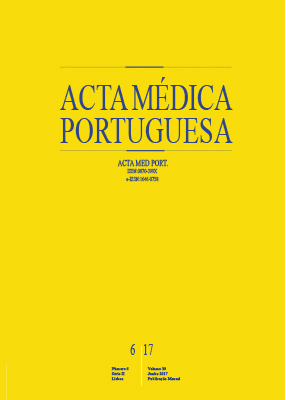A Retrospective Analysis of the Real-Life Utilization of Ranibizumab in Patients with Wet Age-Related Macular Degeneration from Portugal
DOI:
https://doi.org/10.20344/amp.8217Keywords:
Portugal, Ranibizumab, Visual Acuity, Wet Macular DegenerationAbstract
Introduction: Anti-vascular endothelial growth factor therapy has revolutionized the treatment of wet age-related macular degeneration; however, it is important to monitor actual use of ranibizumab and related treatment outcomes in routine practice.
Material and Methods: This was a retrospective, observational study to monitor the 2-year outcomes following ranibizumab treatment for wet age-related macular degeneration in Portugal. Patients treated between January 2009 and December 2009 were retrospectively evaluated. All decisions were made by the treating physician in accordance with their usual routine clinical practice. The primary assessment was mean change in visual acuity score using Early Treatment Diabetic Retinopathy Study or Snellen equivalent.
Results: A total of 128 patients with wet age-related macular degeneration were analyzed (mean age 79.4 years; mean visual acuity score 54.2 letters). Mean change in visual acuity score from baseline was –1.6 letters (n = 82) at year one and –5.1 letters (n = 72) at year two. The mean number of ranibizumab injections was 3.8 (year one) and 1.6 (year two). On average, patients attended 8.6 and 5.0 visits and optical coherence tomography was used in 75.0% of patients in year one and in 56.3% of patients in year two, respectively.
Discussion: Despite a relatively high number of visits, including monitoring visits and use of optical coherence tomography - guided therapy, few injections were administered and visual acuity was not improved.
Conclusion: These findings indicate that as-needed treatment resulted in under-dosing in a real-life setting in Portugal. Such limitations may also be related to increasing numbers of patients, resulting in clinic saturation.
Downloads
Downloads
Published
How to Cite
Issue
Section
License
All the articles published in the AMP are open access and comply with the requirements of funding agencies or academic institutions. The AMP is governed by the terms of the Creative Commons ‘Attribution – Non-Commercial Use - (CC-BY-NC)’ license, regarding the use by third parties.
It is the author’s responsibility to obtain approval for the reproduction of figures, tables, etc. from other publications.
Upon acceptance of an article for publication, the authors will be asked to complete the ICMJE “Copyright Liability and Copyright Sharing Statement “(http://www.actamedicaportuguesa.com/info/AMP-NormasPublicacao.pdf) and the “Declaration of Potential Conflicts of Interest” (http:// www.icmje.org/conflicts-of-interest). An e-mail will be sent to the corresponding author to acknowledge receipt of the manuscript.
After publication, the authors are authorised to make their articles available in repositories of their institutions of origin, as long as they always mention where they were published and according to the Creative Commons license.









